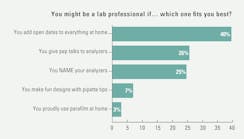Employee training and competency for allied healthcare
and healthcare information technology professionals has taken on a
special urgency in light of the current economic downturn. This economic
crisis may continue for the next decade, meaning that skyrocketing
travel costs will make it more difficult than ever for laboratory
professionals to leave the workplace to access learning opportunities
crucial for keeping pace with advances in the industry and maintaining
certifications — not to mention the training necessary for staying
current with new tools and technologies.
Airfare, rental car fees, and hotel rates are going
through the roof, forcing hospitals and laboratories to trim travel
budgets. “Research suggests annual savings of 40% to 60% among companies
using “anytime, anywhere” online training instead of traditional
classroom instruction. The savings are attributed primarily to greatly
reduced travel and lodging expenses.”1
Hospitals and laboratories are turning to distance
education or distance learning as a way to help their employees fit
training into their busy professional lives and earn the continuing
education credits needed to meet certification requirements.
Why distance learning?
Education and training plays a vital role in
increasing an organization’s revenue and ensuring the maximum return on
investment (ROI) in hiring costs. Continuing education and training are
key elements for retaining the best employees. In 2009 Job Forecast,
a survey of 8,800 workers conducted by CareerBuilder.com from Nov. 12
through Dec. 1, 2008, 23% of workers reported being dissatisfied or very
dissatisfied with the training and learning opportunities provided by
their current employers.2
With a minimal investment in facility, faculty, and
delivery infrastructure, distance learning enables hospitals and
laboratories to provide critical training for employees across sites.
Distance learning can also address information-retention issues.
Research shows that about 70% of information learned in training courses
is forgotten by the time the student needs it. With today’s
technologies, educational information can be presented by an instructor
in a distance-learning class at any site and recorded for viewing
somewhere else later as a refresher. Creating multimedia versions of
courses means that students can instantly refresh their knowledge. Even
a computer- or Web-based version of the program can be created for
“anytime, anywhere” access by employees.
Distance learning has been around since the 19th
century; however, the development of the personal computer was the
“single greatest factor in the explosion of distance or online programs
today.”3 “With the advent of high-power personal computers,
broadband communications, and digital video in the 1990s,
telecommunications-based education started to realize its potential.”4
Educators use the Internet as the medium of choice because it provides
all the elements vital for distance learning: immediate online access to
vast libraries of research materials; on-demand delivery of video, text,
and graphics; and real-time interaction between instructors and
students.5,6 Current technologies support five major
distance-learning application solutions: the Internet, groupware,
educational television, one-way and two-way video, and two-way
audio/video. Distance educators use textbooks, video/audiotapes, CDs,
and the Internet to distribute instructional materials. Some
distance-learning programs employ real-time chat communication in their
courses in which students communicate synchronously.
Why distance learning works
According to a Wall Street Journal article, “…
training classes can be pared into shorter sessions and spread out over
a number of days or weeks — meaning you do not lose an employee for
entire days at a time. … The no-travel-required aspect … means more
time at home and less on the road — no more trips … to learn how to make
a spreadsheet. Shorter training sessions are also a plus for students:
Studies show that retention levels drop (and doodling, no doubt, rises)
significantly after two hours.”7
Distance learning gives employee-students the freedom
and flexibility to learn when and where they want — at their own pace.
They can study a wide range of subjects at any level. Distance learning
is ideal for organizations with multiple facilities,8 and it
provides a way for all of an organization’s staff members to receive
critical training: lab employees who work irregular hours or shifts;
those who live a long way from a training provider; those who have
mobility or health problems that make travel or attendance difficult, or
those whose commitments make it harder to regularly attend a course.
An added advantage to distance education is that it
requires students to develop and use a variety of technical skills; so,
in addition to learning the course subject, students gain proficiency
with a variety of tools — tools that provide an effective means for
communication between them and their instructors. These can include a
combination of written materials (e.g., books and manuals), TV and radio
broadcasts, audiotapes, and CD-ROMs, videoconferencing, e-mail support,
online information, online groups (e.g., listservers), Webinars,
podcasts, wikis and blogs, and social-networking sites. The
“e-instructor” or distance instructor can provide support by telephone,
e-mail, online via posting to a website, or by “snail mail.” To enable
learning, students can communicate with each other via e-mail or
discussion groups.
Setting up a distance-education program
To be most effective and to guarantee maximum ROI,
distance learning must be a part of an overall blended learning
solution. In the search for the right combination of instructional
delivery tools and technologies to achieve maximum result at minimum
cost, an organization might need to look at all potential
distance-education options, understand the true scope and nature of the
project, get all stakeholders’ support early on, effectively communicate
the project scope and requirements to providers, hire the best provider
for the project, and manage the project tasks and milestones to ensure
success.4
Some aspects of distance learning can negatively
impact ROI if an organization does not plan ahead. Determine whether
distance education/learning is right for the organization. Before diving
in, create and test a pilot program to identify possible roadblocks that
might hinder its success, including bandwidth issues, compliance with
standards across sites, limitations to its learning-management system,
and timing constraints. Select courses best suited to distance delivery,
and design them to promote active student learning and to take advantage
of the most appropriate technologies. Using the organization’s existing
tools and technologies puts it one step ahead. Define the program’s
target audience. Clarify the organization’s long-term distance learning
vision so key players know from the outset what courses will be
available, and when and how they will be offered.
For consistency, quality, and success, it is critical
for all team members to communicate throughout the project’s duration.
If telephones will be used for any portion of the project, select a good
long-distance plan to secure reliable and consistent service as well as
to keep telephone costs to a minimum. Poorly managed communications can
cause misunderstandings that can negatively impact on delivery time of
critical training and can increase costs, thus reducing ROI.
When selecting the media to support your
distance-education program, the most critical consideration is that it
adequately supports the learning activities that will be taking place.
Consider the cost, ease of use, and maintenance; integration with other
tools; bandwidth, scalability, and tracking and reporting capabilities.
Having a space, such as an existing conference room, dedicated to
employee training is ideal. Hospital and labs can use distance learning
as a strategy to stretch limited faculty resources since one instructor
can reach multiple sites, and in-house domain experts can double as
instructors. Rather than hiring a professional trainer, many
organizations utilize domain experts with no teaching experience. While
it is sometimes preferable to have a trainer with an education
background, the best instructors are born teachers who enjoy sharing
their knowledge and experience. Since teaching one’s colleagues can be a
challenge, be sure to provide “train-the-trainer” or “-mentor” training
to domain experts/instructors, and give their training staff the support
and tools they need. Confirm that instructors know how to use
distance-learning technology. The success of any
distance-education/-learning program — and any organization’s ROI —
depends on the ability of instructors to deliver training successfully
across sites.
Distance-learning instruction techniques, suggestions
When instructing by way of technology, adopting a
learner-centered approach is usually most successful. Instructors should
get to know their students. Personal contact and relationship building
are important components of effective education programs and even more
critical in distance education. Develop strategies for facilitating and
promoting student-teacher interaction. Rotating the host facility is one
option that gives employee-students at different sites the opportunity
to share directly a best practice or a new, time-saving technique
face-to-face with the instructor.
A successful distance-learning program is one whose
training staff encourages collaboration in order to build a sense of
community among students. Instructors must consider engaging
employee-students at different sites so they feel that they have a
shared mission. Deliver a training session from each site to give each
facility the opportunity to be the host location. Key is getting buy-in
from each student and each site to encourage maximum participation. Some
courses (e.g., system file setup training) are not suitable for a
distance-learning format. For this type of training, have a “traveling”
instructor who can go to each site for training or provide
“train-the-trainer” instruction so each site has a dedicated software
trainer.
Students should possess at least the minimum
technical skills. If the organization offers a class on system file
setup of a Windows-based application, students should know how to use a
mouse or similar peripheral device, and they should have a working
knowledge of using an application with a graphical user interface. Also,
if a program uses a third-party tool (e.g., a word-processing program to
create templates and tables), students should meet a minimal-skill
requirement or be able to pass a skills assessment on the selected
program. Unless the course is on basic skills training, instructors
should not get bogged down teaching remedial skills and wasting class
time because a student does not meet the minimum-skills requirement.
Provide instruction in technology and technical
support throughout the course; if possible, provide a help line staffed
by a tech-savvy team member to enable quick resolution of problems so
instructors can concentrate on course content. If the organization does
not set up a help desk, instructors can potentially be bombarded with
e-mail related to technical support.
Tips for distance-learners
A good distance-learning course offers more than a
lecture and notetaking, and it requires high motivation on the part of
the student. Students and instructors separated by time and distance
have to work at effectively communicating since they may never meet, and
real learning requires interaction between students and
instructors. Seize opportunities to interact by creating a support group
to discuss coursework, ask questions, seek assistance, work
collaboratively on group projects, study, and strengthen personal
commitment to the program.
Students need to understand and meet technology
requirements. If a course requires a computer with an Internet
connection, students should have at least the minimum amount of memory
and speed (no dial-up). If a course requires telephone use, students
should have a reliable, cost-effective long-distance carrier or
cellular-phone service provider, especially if they are working on a
group project. They need to learn how to use discussion boards or any
specialized software tools, and how to reach technical support if they
have issues. They should also find out in advance whether there is a
dedicated help desk and whether an orientation will be offered prior to
the first class.
As a participant, a student is responsible for his
own success. If he has time, he can explore the subject matter on his
own. Just as important as an organization’s return on this training
investment for its employees is a employee-student’s own return on the
investment of his time and effort.
Tough economic times are ripe for hospitals and labs
to find ways to help adapt and establish good business and learning
practices that can continue when the economic harvest comes. By
incorporating distance learning, staff will benefit from improved access
to critical training, and the organization will be able to invest
savings on travel costs into continued improvements to its training
program. A well-designed, flexible, and convenient distance-learning
program can enable busy allied healthcare and healthcare IT
professionals to easily fit continuing education into their family and
job commitments, and other obligations. This is the primary reason
distance learning has become the preferred choice among busy students
and working adults.
Don Keller is vice president of Global Education and Training, and Chief Learning
Officer, for SCC Soft Computer, Clearwater, FL. SCC’s Educational
Services Department has been ranked in Training magazine’s annual survey
of the top companies for workforce training and development for seven of
the past eight years; the company ranked third in the 2009 Training Top
125. Martha Abell Shrader,
senior corporate communications analyst, Educational Services, SCC Soft
Computer, contributed to this article. See SCC Soft Computer’s “Distance
Learning Timeline” online with this article.
References
- O’Mara H. Improve Training, Cut Costs With
E-Learning Programs. Los Angeles
Business Journal,
11/20/2000. Available at
http://www.allbusiness.com/technology/computer-software/685960-1.html .
Accessed February 4, 2009. - Available at
www.careerbuilder.com/share/aboutus/pressreleasedetails.aspx.
Accessed January 30, 2009. - History of Online/Distance Public Education in
America. Available at
http://www.adultlearn.com/history-education.html . Accessed February
3, 2009. - Harting K, Erthal MJ. History of Distance
Learning. Available at
http://www.osra.org/itlpj/hartingerthalspring2005.pdf . Accessed Februay 3, 2009. - Freed K. A History of Distance Learning:
Interactive Distance Learning. Available at
www.media-visions.com/ed-distlrn3.html . Accessed February 3, 2009. - A History of Distance Learning. Available at
http://www.ncsu.edu/student)affairs/detag/meeting/history020604.ppt .
Accessed February 3, 2009. - Pretti, S. Internet Learning. News & Views.
Philadelphia Metro Chapter of the Society for Technical
Communications (STC). November 1998. - Directgov, Education and learning, e-learning. Available at
http://www.direct.gov.uk/en/EducationAndLearning/AdultLearningOutsideTheClassroom/DB_4016860.
Accessed January 26, 2009.
The foundation of distance education and learning: A timelinexx
1840
— Sir Isaac Pitman first uses distance learning in Bath, England, to
teach students what is now the most widely used system of shorthand,
known today as Pitman’s Shorthand, by instructing his students to copy
short Bible verses “and return them via Britain’s penny-post system for
grading.”10
1873 — Anna Ticknor, one of the pioneers of distance education in the United
States, establishes the Society to Encourage Studies at Home, which
increased educational opportunities for women by offering courses to
young women kept at home by the conventions of their time. In its
24-year history, this Boston-based organization served over 10,000
students and set the standard for other home-based correspondence study
courses.11
1883 — he first official recognition of correspondence education takes place
when the Chautauqua College of Liberal Arts in New York grants degrees
to students who successfully complete academic work through
correspondence education and summer workshops.12
1892 — The University of Chicago introduces the first university-level
correspondence school in the United States to make higher education more
accessible to those who otherwise would not have been able to afford the
high cost of full-time residence at an educational institution.
1896 — Indiana’s Central University becomes one of the first institutions to
allow students to earn bachelors, masters, or doctoral degrees entirely
through correspondence classes. The program is still in existence today.
Until 1910 — The postal system remains the primary delivery system for distance
education. New technologies, such as the lantern slide13 and
motion picture emerge to provide additional, visually-based options for
correspondence study.
1913 — Thomas Edison proclaims that due to the invention of film, “our
schools will be completely changed within the next 10 years.” The
dramatic change Edison predicted did not occur, but instructional media
were introduced into many extension programs by 1920 in the form of
slides and motion pictures.14
1915 — The National University Extension Association is formed following a
call by academics to research the effectiveness of correspondence
education vs. traditional education. Technology has been the key element
to the evolution of distance learning.15
1920s and 1930s — Correspondence courses grow in popularity as schools deliver courses
over radio.
1932 — The University of Iowa begins experimenting with transmitting
instructional television courses seven years before television is
introduced at the New York World’s Fair.16 The introduction
of television is impeded by World War II.
1933 — A survey of the University of Chicago faculty suggests that the
justification of correspondence study should be rooted in its
experimental nature, and that it should generate innovations and
research data that would lead to improvements in teaching methodologies.
Henry Ford writes to the President advocating the formation of a
University Without Walls.17 (Pioneering efforts such as the
University Without Walls project at Sierra University promotes
methodologies of student-centered learning and the use of community
resources as the student’s campus well into the 1970s.)
1940s and 1950s — Mail-based correspondence courses increase as GIs use their military
benefits to pay for their education after World War II and the Korean
War. The interwar years see the development of education by radio, with
many universities and colleges granted broadcasting licenses. Although
educational radio was seen as popular, the only college credit course
offered by radio by 1940 fails to attract any enrollments.18
1956 — With a Ford Foundation grant, Gale Childs initiates a project to study
the effectiveness and reliability of correspondence study as an
educational method and the application of television instruction in
combination with correspondence study. He concludes that television
instruction is an instrument for transmitting instruction, not a method
in itself.19,20
1959 — Educational television proves more effective than education by radio,
with Chicago’s Sunrise Semester offering filmed classes.
1960s — The baby boom and availability of television are the driving forces
behind states creating and expanding regional colleges and universities
that make a college education available to millions of Americans who
would not have otherwise had access to higher education.
1963 — Instructional Television Fixed Service (ITFS) reserves select
transmission frequencies for educational instruction.
1967 — The Public Broadcasting Act of 1967 establishes the Corporation for
Public Broadcasting.
1969 — Open University is founded in the United Kingdom as a degree-granting
institution and brings “a new vision of independence for distance
education as distinct from traditional education.”21 The
British Open University utilizes television as well as correspondence
methods. The trend of Open University is adopted in the United States in
the 1970s. OU offers courses by correspondence, television, and radio
that make degree study a reality for working adults. Programs such as
those at Columbia Pacific University attain worldwide popularity and
acclaim, with leading universities such as Harvard and Yale stating that
they would be happy to consider graduates of such programs for admission
to further degrees.22
Early 1970s — Universities begin to set up microwave networks to take advantage of
the ITFS, which allows links to regional campuses and other
universities.23
1970s — The Public Broadcasting Service (PBS) starts production on full
telecourses, which are eventually franchised to local PBS stations.
Coastline Community College and Dallas Community College make serious
use of television. Coastline is one of the first “virtual colleges” in
the United States serving 18,500 students in California by 1976. Dallas
takes the important step of putting its courses on videotape to be sent
to other colleges.24
1971 — Empire State College, the first Open University in the United States
and a pioneer in distance education, opens.
1972 — There are now 233 educational stations in the United States. Ohio
University, The University of Texas, and the University of Maryland are
among the earliest universities to create networks to reach both
on-campus and off-campus student populations.25
1978 — First computer Bulletin Board Systems (BBS) created by Ward
Christianson goes online. Bulletin Board Systems were the predecessors
to the World Wide Web. In the 1980s, before the Internet became widely
used, bulletin-board systems became increasingly popular as a base for
communications between geographically dispersed users who accessed the
BBS over telephone lines. Thousands of BBSs sprang up across North
America and other locations, many becoming tremendously useful, lively
virtual communities.26
Early 1980s — Videoconferencing through programs such as the ITFS enables students
to take college courses live in a classroom setting or delivered to a
remote location via microwave. Cable and satellite television become
delivery mediums for distance-education courses.
1982 — Programs like the Florida Engineering Education Delivery System
(FEEDS) at the University of South Florida in Tampa enable engineers
from firms like Honeywell and Lockheed Martin to take advanced
engineering courses on campus in a traditional, instructor-led class —
broadcast simultaneously over microwave — or delivered on videocassette
to their places of business.
1984 — At universities in the United States, the first online undergraduate
courses are offered.
1987 — Glenn Jones launches Mind Extension University, a cable television
channel that carries varied educational television programming — much of
it for participating colleges and universities.
1989 — At universities in the United States, the first online degree program
is offered.
Early 1990s — Cable lines make two-way television possible. Improvements in
data-compression technology improve videoconferencing.
Late 1990s — Widespread access to the World Wide Web and new course platforms
enable teachers to post courses on the Internet. “The explosive growth
of the Internet, in fact, changed the essential character of delivering
educational content to remote students.”27 The term, distance
learning, is coined to describe the process, which no longer relied on
television. The development of computer networking and
videoconferencing, satellite- and microwave-delivery systems, and
improvements in bandwidth have removed geographical barriers and have
made distance learning accessible to students around the world today.
2001 — The Internet is becoming increasingly popular. The National Center for
Education Statistics reports that 90% of the institutions offering
distance-education courses offered Internet courses using asynchronous
computer-based instruction, and 43% offered Internet courses using
synchronous computer-based instruction.28
Present day — Despite bandwidth issues in some areas, the Internet has become medium
of choice for educators because it provides the key elements for
distance learning: “on-demand delivery of video, audio, text, and
graphics; immediate online access to vast libraries of research
materials; and real-time or near real-time interaction between
instructors and students.”29





